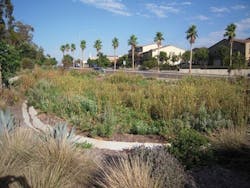About the author: Jonard Talamayan is assistant engineer, civil, for the city of San Diego's Transportation & Storm Water Department. Talamayan can be reached at [email protected] or 858.541.4334.
The city of San Diego seized an opportunity to pilot a green street project in the Chollas Creek watershed, a highly urbanized watershed that has total maximum daily loads (TMDLs) for copper, lead and zinc. In addition to regulating TMDL requirements, the California Regional Water Quality Control Board, San Diego Region, also enforces a Regional Municipal Separate Storm Sewer System (MS4) Permit that requires development projects of a certain size to construct pollutant control best management practices (BMPs) to treat storm water runoff.
The 43rd Street and Logan Avenue Intersection Realignment Project served as an ideal pilot site to test and build green street concepts with pollutant control BMPs in an effort to demonstrate compliance with increasingly stringent water quality regulations. These regulations affect many public improvement projects, and are particularly challenging to meet when there is limited right-of-way space available. In addition to the TMDL requirements, there were other pollutants of concern for this project, including indicator bacteria, trash and fipronil—an insecticide used for flea and tick removal that the city decided to monitor due to increasing environmental concern. It was important for this pilot project to demonstrate that these pollutants could be filtered out of storm water runoff entering Chollas Creek, which empties to San Diego Bay, and ultimately the Pacific Ocean.
Flow and water quality monitoring for the biofiltration basin was measured from the influent from the curb inlet and the effluent at the end of the perforated pipe after treatment.
Biofiltration Basin
On one corner of the intersection, the city installed a vegetated biofiltration basin that collects approximately 0.4 acres of roadway runoff and treats the 5-year design flow. The basin was sized to meet such a large storm event due to extra space available after the realignment project. Although greater pollutant load reductions typically are seen in basins that allow for partial or full infiltration into native soils, a conservative design approach was taken in order to pass engineering and operational review. Therefore, an impermeable liner was placed at the bottom of the basin.
Testing Filtration Units
Across the street, the city installed a series of non-proprietary underground filtration units to treat about 3 acres of primarily roadway flow and some portions of residential and commercial parcels. Designed to treat the 85th percentile flow (0.58 cu ft per second), the original design allowed for runoff to enter multiple curb inlets and pass through volcanic rock, and move vertically into filtration media consisting of 6 in. of zeolite, 1 ft of clean sand, and 1 ft of ¾-in. crushed rock before conveying to the downstream storm drain network via a perforated underdrain.
The initial design showed that design flows bypassed the filtration unit inlet, prompting the need to retrofit the BMP. The city decided to redesign the BMP so all storm water flows enter one pretreatment vault inlet before being conveyed to each filtration unit chamber. Literature review was performed to characterize the 85th percentile trash loading rates at the project site. Full-scale simulated runoff testing for pretreatment configurations also was performed to determine the optimal design.
In conjunction with the pretreatment study, the city conducted a filtration media study to develop a mix effective for pollutant removal at a depth less than the existing 18-in. filtration media to provide head space for full capture of the intended water quality design flow. Column tests were conducted for several filtration media mixes to determine a soil composition that would yield both high pollutant removal efficiency and high flow rates through the media. The study recommended 14 in. of filtration media consisting of 30% rhyolite sand, 30% zeolite, 30% granular activated carbon, and 10% peat moss.
Performance Review
The State Water Resources Control Board awarded the city with Storm Water Grant Program Proposition 84 funds to monitor the performance of the biofiltration basin and filtration units. Monitoring pollutant removal is necessary to determine if these pollutant control BMPs can be implemented citywide. The grant called for the city to develop a monitoring plan to conduct storm event water quality and flow monitoring, surface water level monitoring during and after storm events, soil moisture content monitoring, and soil sampling. The monitoring team agreed to monitor storms that had a forecast of at least 0.25 in. of rainfall with a 75% to 100% probability during the 2014-2015 and 2015-2016 wet weather seasons. In total, seven storms were monitored.
The strength of this pilot project was that both the biofiltration basin and filtration units were designed to be monitored. Both BMPs were designed to be instrumented with flumes, weirs, flow measure meters, and telemetry equipment to measure water quality and flow rates. Flow-weighted composite samples were collected at the influent and effluent of each BMP for water quality analysis, with the exception of bacteria and hydrocarbons, which were collected via grab samples.
Flows that bypass filtration will enter the storm drain structure through a raised catch basin at the low end of the basin.
Monitoring Results
Both the biofiltration basin and filtration units demonstrated pollutant removal benefits with respect to dissolved lead, copper and zinc. Based on the seven monitored storms, the biofiltration basin achieved an approximate 71% reduction in dissolved lead, 2% reduction in dissolved copper, and 93% reduction in dissolved zinc, whereas the filtration units achieved a 44% reduction in dissolved lead, 41% reduction in dissolved copper, and 62% reduction in dissolved zinc. All monitoring data can be found on the California Environmental Data Exchange Network.
Although many pollutants were successfully filtered, the biofiltration basin showed an export of nutrients, possibly attributed to the compost in the bioretention soil media mix, which had a specification that called for 65% to 70% loamy sand and 30% to 35% compost. Since construction, the city has developed a standard bioretention soil media specification that seeks to address potential nutrient leaching by improving the compost quality in filtration media. In addition, due to the limited number of samples and storm events, no clear trend was developed to quantify bacteria load reductions.
Further monitoring at other pilot projects is needed to determine long-term trends and inform future BMP designs before citywide implementation can occur.


